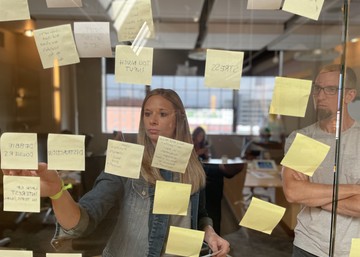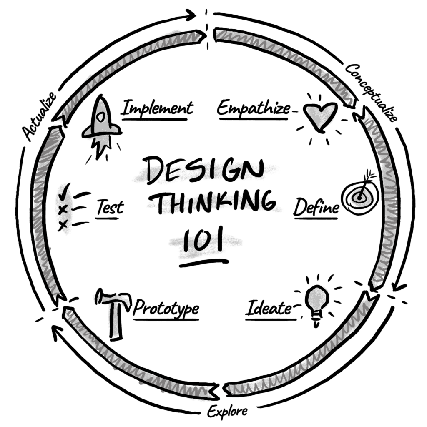

When we talk with people about design thinking, we often hear that there is confusion about what it is, how it’s done and how it can be applied. This article aims to shed light on the answers to those questions.
What is Design Thinking?
Design thinking has been around for decades — centuries, even. Thomas Edison’s invention of the light bulb and an industry surrounding it is sometimes cited as an early example of what is now called design thinking.
Definitions of design thinking vary. In a pivotal 2008 Harvard Business Review article, Tim Brown, CEO and President of the design consulting firm IDEO, refers to it as “a discipline that uses the designer’s sensibility and methods to match people’s needs with what is technologically feasible and what a viable business strategy can convert into customer value and market opportunity.”
A simpler definition that we like, from a more recent Harvard Business Review article, is this: “a mindset and approach to problem-solving and innovation anchored around human-centered design.”
It is, in fact, a mindset, an approach, a system, a set of principles, a strategic process and a tool set — a way of thinking, collaborating and problem solving that is built on a deep, empathetic understanding of human needs and behavior. It’s that simple, really. It’s a way of codifying and systematizing what many design teams do, so that others can apply it and “think like designers.”
If you like to learn from video, check out this two-minute explainer video from Harvard Business Review.
What is the Design Thinking “Process”?
The stages in the design thinking process also vary by source. The above Harvard Business Review video labels the stages as: “Invent a Future,” which includes empathizing with users and generating hypotheses; “Test,” which includes iterative prototyping, experimentation, and adjusting; and “Bring the New Product or Service to Life.” In his book Change By Design, Tim Brown of IDEO describes the “system of overlapping spaces” as Inspiration, Ideation and Implementation, which is a good summary.
We often use the following description of the process, from our friends at Voltage Control, as it contains a bit more detail. It is important to note that this process is not always as linear as it appears. As Brown notes in Change by Design: “Insofar as it is open-ended, open-minded and iterative, a process fed by design thinking will feel chaotic to those experiencing it for the first time.”
Below are quick notes on each stage.
Empathize: Gather user insights and empathy from observation, interviews and other sources, and summarize them in memorable and actionable terms. This step is essential to the success of the work.
Define: Work together to get crystal clear on what problem or problems we are trying to solve. These are articulated as “How Might We” statements.
Ideate: Use a mix of divergent and convergent thinking to generate numerous ideas for solving the identified problem. Sort them into “sets” of ideas and narrow them to those we hypothesize have the highest chance of success in the market.
Prototype: Develop prototypes, often quite simple, of the ideas to be tested. These can take many different forms, from narratives to working models.
Test: Test the ideas with would-be users. Iterate and re-test as necessary.
Implement: Bring the idea to life in the market.
As you can see, it’s a pretty “simple” process. Much of the beauty of it lies in the collaboration; for the best results, design thinking work involves multidisciplinary teams, as divergent points of view can spur new insights and ideas. Designers are encouraged to gather insights. Insights and strategy team members are encouraged to contribute ideas and develop prototypes. It softens traditional role-based siloes.

How Can it Be Applied?
In “textbook” terms, design thinking is often applied to the design of new products and services, as noted in the explainer video above.
An IDEO article details 11 products and services made using design thinking, including Airbnb, the Braun Oral-B electric toothbrush, and the LA County voting system.
Another popular example is how GE Healthcare used design thinking to redesign MRI machines to be less frightening for children. They observed children in various environments, spoke to experts and interviewed hospital staff to gain more insight. After extensive research, pilots and iteration, they launched their “Adventure Series.” As noted in a Harvard Business School article: “The “Pirate Adventure” transforms MRI machines from dark, black holes to pirate ships with scenery of beaches, sandcastles and the ocean. By empathizing with children’s pain points, GE Healthcare was able to craft a creative solution that was not only fun but increased patient satisfaction scores by 90 percent.”
At Core, we are applying the design thinking mindset and toolset more broadly. Currently, we are using it to design an experiential brand activation for a client, as well as for ideating how some advertising campaigns might be made more useful. Our entire Core Brand team went through formal design thinking training last year, because as part of our “boundless pursuit of better” mission we are always looking for new ways to increase the impact of our work. We wouldn’t say we have it “all figured out,” yet. How we apply design thinking will continue to shift and change, as fluid as the process itself. But we can say that as a mindset and a toolset, we are finding it incredibly valuable.
If I had to sum up design thinking in a simple sentence, I would say:
Deep user or customer empathy is a powerful spark for new ideas that make things better.
Interested in understanding how design thinking can help with your marketing challenge? Let's talk.


